Study on Impact Resistance of All-Lightweight Concrete Columns Based on Steel Fiber Reinforced and Various Axial Compression Ratio
Abstract
:1. Introduction
2. Experimental Program
2.1. Specimen Design and Fabrication
2.2. Material Properties
2.3. Test Setup and Test Program
3. Results and Discussion
3.1. Specimen Damage Pattern
3.2. Time Course Analysis of Impact Force
3.3. Acceleration Time Course Analysis
3.4. Time History Analysis of Mid-Span Displacement
3.5. Dynamic Strain Time Analysis
3.6. Energy Dissipation Analysis
4. Conclusions
- (1)
- Under the impact load, many shear and bending cracks were generated in the local area of the span, resulting in the formation of a wedge-like local punching and shearing zone in the span. At the axial compression ratios of 0.1, 0.2, and 0.3, the specimens suffered bending shear damage, shear damage, and punching damage, respectively, and their crack patterns were dominated by bending cracks, shear cracks, and punching-type shear cracks, respectively.
- (2)
- When the axial compression ratio was increased from 0.1 to 0.2 and 0.2 to 0.3, respectively, the impact force primary peak increased by 8.7%, 9.8%, the secondary peak increased by 3.2%, 213.3%, the acceleration peak decreased by 30.81%, 8.4%, the maximum displacement in the span increased by 8.3%, 53.8%, and the residual displacement in the span increased by 65.9%. The deformation energy consumption is increased by 12.37% and 104.32%, respectively. The test results indicate that increasing the axial compression ratio can improve the specimen’s stiffness and damping, reduce the structure’s vibration amplitude, and make the structure have a better energy absorption capacity for impact loads. However, the effect of increasing the axial pressure ratio on the deformation and long-term stability of the structure needs to be carefully evaluated. There may be critical values in the range of axial pressure ratios increasing from 0.2 to 0.3, beyond which the impact response of the structure is significantly enhanced.
- (3)
- Under the impact load, the force distribution of the concrete inside the specimen gradually shifts toward the mid-span position as the axial compression ratio increases. This phenomenon leads to a gradual increase in the strain value of the hoop reinforcement in the specimen’s cross-section toward the span, which means that the strain will be more concentrated at the span center.
- (4)
- The addition of shear-wave steel fibers as reinforcing material to the ALWC columns with an axial compression ratio of 0.2 significantly improved the impact resistance and stiffness of the columns while reducing the generation of cracks. The concrete at the impact point did not show any stripping of aggregates. Compared with the specimens without steel fiber addition, the damage mode of the specimens changed from shear damage to bending damage, with a 3.2% increase in the primary peak, a 186% increase in the secondary peak, a 48.71% decrease in the maximum acceleration peak, 21.5% decrease in the maximum mid-span displacement, a 27.4% decrease in the residual displacement, and a 36.6% increase in the energy dissipation capacity.
Author Contributions
Funding
Data Availability Statement
Conflicts of Interest
References
- Kiakojouri, F.; De Biagi, V.; Chiaia, B.; Sheidaii, M.R. Progressive Collapse of Framed Building Structures: Current Knowledge and Future Prospects. Eng. Struct. 2020, 206, 110061. [Google Scholar] [CrossRef]
- Yang, T.; Chen, W.; Han, Z. Experimental Investigation of Progressive Collapse of Prestressed Concrete Frames after the Loss of Middle Column. Adv. Civ. Eng. 2020, 2020, 8219712. [Google Scholar] [CrossRef]
- Abdelwahed, B. A Review on Building Progressive Collapse, Survey and Discussion. Case Stud. Constr. Mater. 2019, 11, e00264. [Google Scholar] [CrossRef]
- Xiang, S.; Zeng, L.; Liu, Y.; Mo, J.; Ma, L.; Zhang, J.; Chen, J. Experimental Study on the Dynamic Behavior of T-Shaped Steel Reinforced Concrete Columns under Impact Loading. Eng. Struct. 2020, 208, 110307. [Google Scholar] [CrossRef]
- Ye, J.-B.; Cai, J.; Chen, Q.-J.; Liu, X.; Tang, X.-L.; Zuo, Z.-L. Experimental Investigation of Slender RC Columns under Horizontal Static and Impact Loads. Structures 2020, 24, 499–513. [Google Scholar] [CrossRef]
- Cai, J.; Ye, J.-B.; Chen, Q.-J.; Liu, X.; Wang, Y.-Q. Dynamic Behaviour of Axially-Loaded RC Columns under Horizontal Impact Loading. Eng. Struct. 2018, 168, 684–697. [Google Scholar] [CrossRef]
- Gholipour, G.; Zhang, C.; Mousavi, A.A. Effects of Axial Load on Nonlinear Response of RC Columns Subjected to Lateral Impact Load: Ship-Pier Collision. Eng. Fail. Anal. 2018, 91, 397–418. [Google Scholar] [CrossRef]
- Sun, J.-M.; Yi, W.-J.; Chen, H.; Peng, F.; Zhou, Y.; Zhang, W.-X. Dynamic Responses of RC Columns under Axial Load and Lateral Impact. J. Struct. Eng. 2023, 149, 04022210. [Google Scholar] [CrossRef]
- Al-Bukhaiti, K.; Yanhui, L.; Shichun, Z.; Abas, H.; Daguang, H.; Nan, X.; Lang, Y.; Yu, Y.X. Effect of the axial load on the dynamic response of the wrapped CFRP reinforced concrete column under the asymmetrical lateral impact load. PLoS ONE 2023, 18, e0284238. [Google Scholar] [CrossRef]
- Pham, T.M.; Zhang, X.; Elchalakani, M.; Karrech, A.; Hao, H.; Ryan, A. Dynamic Response of Rubberized Concrete Columns with and without FRP Confinement Subjected to Lateral Impact. Constr. Build. Mater. 2018, 186, 207–218. [Google Scholar] [CrossRef]
- Fan, W.; Xu, X.; Zhang, Z.; Shao, X. Performance and Sensitivity Analysis of UHPFRC-Strengthened Bridge Columns Subjected to Vehicle Collisions. Eng. Struct. 2018, 173, 251–268. [Google Scholar] [CrossRef]
- Liu, Y.; Dong, A.; Zhao, S.; Zeng, Y.; Wang, Z. The Effect of CFRP-Shear Strengthening on Existing Circular RC Columns under Impact Loads. Constr. Build. Mater. 2021, 302, 124185. [Google Scholar] [CrossRef]
- Zhang, J.; Maalej, M.; Quek, S.T. Performance of Hybrid-Fiber ECC Blast/Shelter Panels Subjected to Drop Weight Impact. J. Mater. Civ. Eng. 2007, 19, 855–863. [Google Scholar] [CrossRef]
- Wu, Z.; Shi, C.; He, W.; Wu, L. Effects of Steel Fiber Content and Shape on Mechanical Properties of Ultra High Performance Concrete. Constr. Build. Mater. 2016, 103, 8–14. [Google Scholar] [CrossRef]
- Ren, G.M.; Wu, H.; Fang, Q.; Liu, J.Z. Effects of Steel Fiber Content and Type on Static Mechanical Properties of UHPCC. Constr. Build. Mater. 2018, 163, 826–839. [Google Scholar] [CrossRef]
- Jin, L.; Zhang, R.; Dou, G.; Du, X. Fire Resistance of Steel Fiber Reinforced Concrete Beams after Low-Velocity Impact Loading. Fire Saf. J. 2018, 98, 24–37. [Google Scholar] [CrossRef]
- Cao, Y.; Alyousef, R.; Baharom, S.; Shah, S.N.R.; Alaskar, A.; Alabduljabbar, H.; Mustafa Mohamed, A.; Assilzadeh, H. Dynamic Attainment of Mixed Aspect Ratio for Concrete Members Reinforced with Steel Fiber under Impact Loading. Mech. Adv. Mater. Struct. 2022, 29, 1986–1995. [Google Scholar] [CrossRef]
- Rafieizonooz, M.; Khankhaje, E.; Rezania, S. Assessment of environmental and chemical properties of coal ashes including fly ash and bottom ash, and coal ash concrete. J. Build. Eng. 2022, 49, 104040. [Google Scholar] [CrossRef]
- Mi, H.; Yi, L.; Wu, Q.; Xia, J.; Zhang, B. Preparation of High-Strength Ceramsite from Red Mud, Fly Ash, and Bentonite. Ceram. Int. 2021, 47, 18218–18229. [Google Scholar] [CrossRef]
- Liu, S.; Yang, C.; Liu, W.; Yi, L.; Qin, W. A Novel Approach to Preparing Ultra-Lightweight Ceramsite with a Large Amount of Fly Ash. Front. Environ. Sci. Eng. 2020, 14, 62. [Google Scholar] [CrossRef]
- Bernardo, L.F.A.; Nepomuceno, M.C.S.; Pinto, H.A.S. Flexural ductility of lightweight-aggregate concrete beams. J. Civ. Eng. Manag. 2016, 22, 622–633. [Google Scholar] [CrossRef]
- Zhou, Y.; Liu, X.; Xing, F.; Cui, H.; Sui, L. Axial Compressive Behavior of FRP-Confined Lightweight Aggregate Concrete: An Experimental Study and Stress-Strain Relation Model. Constr. Build. Mater. 2016, 119, 1–15. [Google Scholar] [CrossRef]
- Cui, H.Z.; Lo, T.Y.; Memon, S.A.; Xu, W. Effect of Lightweight Aggregates on the Mechanical Properties and Brittleness of Lightweight Aggregate Concrete. Constr. Build. Mater. 2012, 35, 149–158. [Google Scholar] [CrossRef]
- GB 50010-2010; Code for Design of Concrete Structures. Standards Press of China: Beijing, China, 2010.
- JGJ/T12-2019; Technical Standard for Application of Lightweight Aggregate Concrete. Standards Press of China: Beijing, China, 2019.
- JGJ/T12-2010; Technical Specification for Application of Fiber Reinforced Concrete. Standards Press of China: Beijing, China, 2010.
- GB/T 39147-2020; Steel Fiber for Concrete. National Standardization Management Committee: Beijing, China, 2020.
- Zhao, D.-B.; Yi, W.-J.; Kunnath, S.K. Shear Mechanisms in Reinforced Concrete Beams under Impact Loading. J. Struct. Eng. 2017, 143, 04017089. [Google Scholar] [CrossRef]
- Wei, J.; Li, J.; Wu, C. An Experimental and Numerical Study of Reinforced Conventional Concrete and Ultra-High Performance Concrete Columns under Lateral Impact Loads. Eng. Struct. 2019, 201, 109822. [Google Scholar] [CrossRef]
- Beppu, M.; Kataoka, S.; Mori, K.; Ichino, H. Local damage characteristics of reinforced concrete slabs subjected to hard/deformable projectile impact. Adv. Struct. Eng. 2022, 25, 1505–1518. [Google Scholar] [CrossRef]
- Sawamoto, Y.; Tsubota, H.; Kasai, Y.; Koshika, N.; Morikawa, H. Analytical Studies on Local Damage to Reinforced Concrete Structures under Impact Loading by Discrete Element Method. Nucl. Eng. Des. 1998, 179, 157–177. [Google Scholar] [CrossRef]
- Yan, Q.; Sun, B.; Liu, X.; Wu, J. The Effect of Assembling Location on the Performance of Precast Concrete Beam under Impact Load. Adv. Struct. Eng. 2018, 21, 1211–1222. [Google Scholar] [CrossRef]
- Smoller, J. Shock Waves and Reaction—Diffusion Equations (Vol. 258); Springer Science & Business Media: Berlin, Germany, 2012. [Google Scholar]
- Zhang, X.; Liu, Z.; Wang, F. Autogenous Shrinkage Behavior of Ultra-High Performance Concrete. Constr. Build. Mater. 2019, 226, 459–468. [Google Scholar] [CrossRef]
- Gholamhoseini, A.; Khanlou, A.; MacRae, G.; Scott, A.; Hicks, S.; Leon, R. An Experimental Study on Strength and Serviceability of Reinforced and Steel Fibre Reinforced Concrete (SFRC) Continuous Composite Slabs. Eng. Struct. 2016, 114, 171–180. [Google Scholar] [CrossRef]
- Wu, L.; Farzadnia, N.; Shi, C.; Zhang, Z.; Wang, H. Autogenous Shrinkage of High Performance Concrete: A Review. Constr. Build. Mater. 2017, 149, 62–75. [Google Scholar] [CrossRef]
- Zhan, Y.; Meschke, G. Multilevel Computational Model for Failure Analysis of Steel-Fiber–Reinforced Concrete Structures. J. Eng. Mech. 2016, 142, 04016090. [Google Scholar] [CrossRef]
- Kang, S.-T.; Lee, Y.; Park, Y.-D.; Kim, J.-K. Tensile Fracture Properties of an Ultra High Performance Fiber Reinforced Concrete (UHPFRC) with Steel Fiber. Compos. Struct. 2010, 92, 61–71. [Google Scholar] [CrossRef]
- Huang, H.; Gao, X.; Li, L.; Wang, H. Improvement Effect of Steel Fiber Orientation Control on Mechanical Performance of UHPC. Constr. Build. Mater. 2018, 188, 709–721. [Google Scholar] [CrossRef]

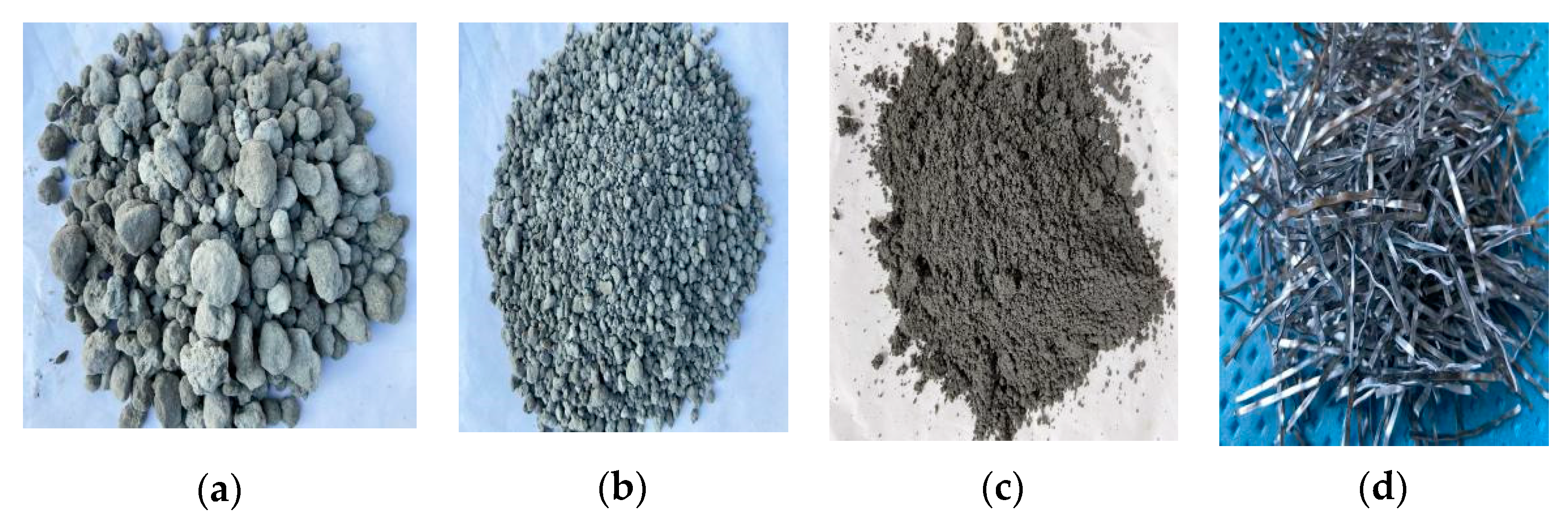
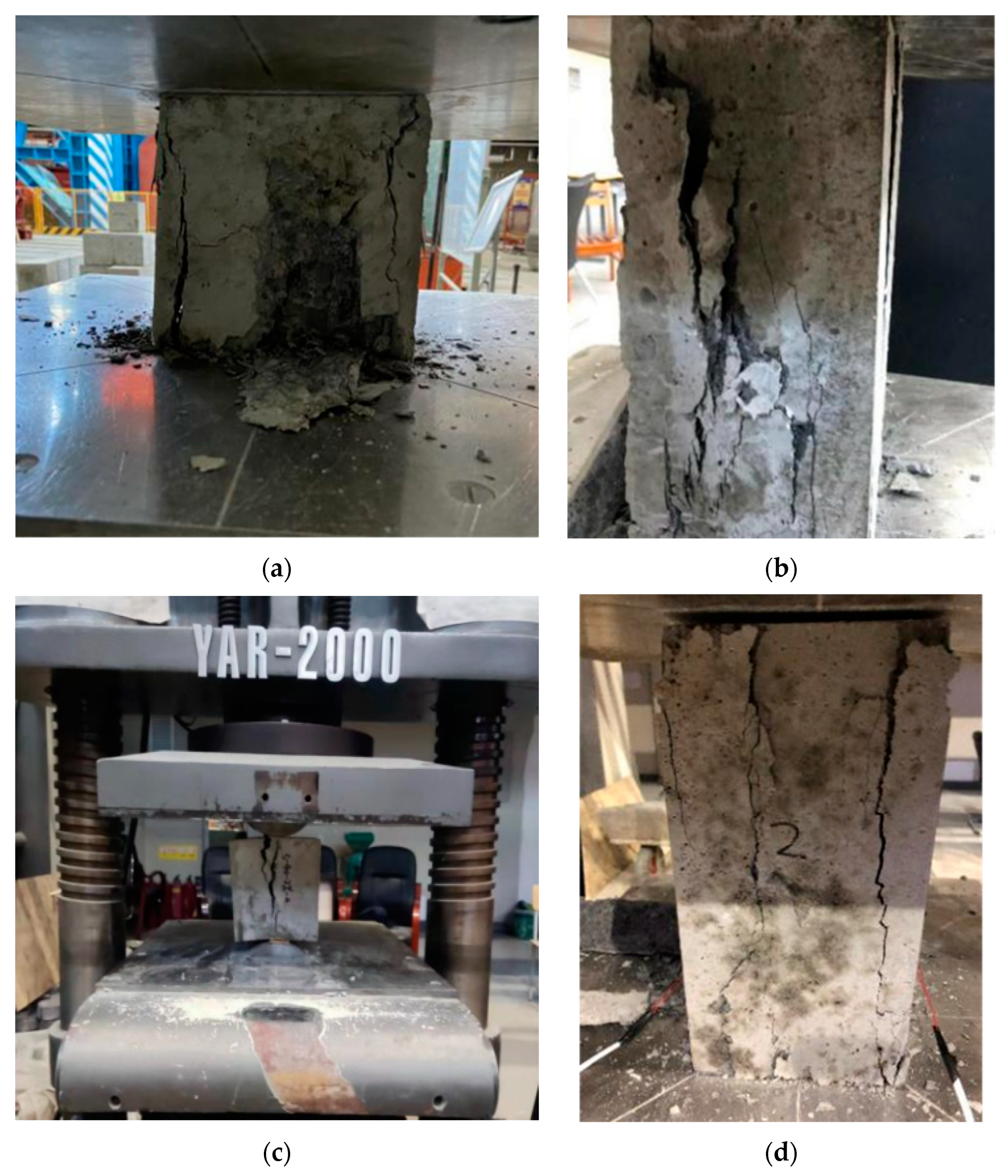
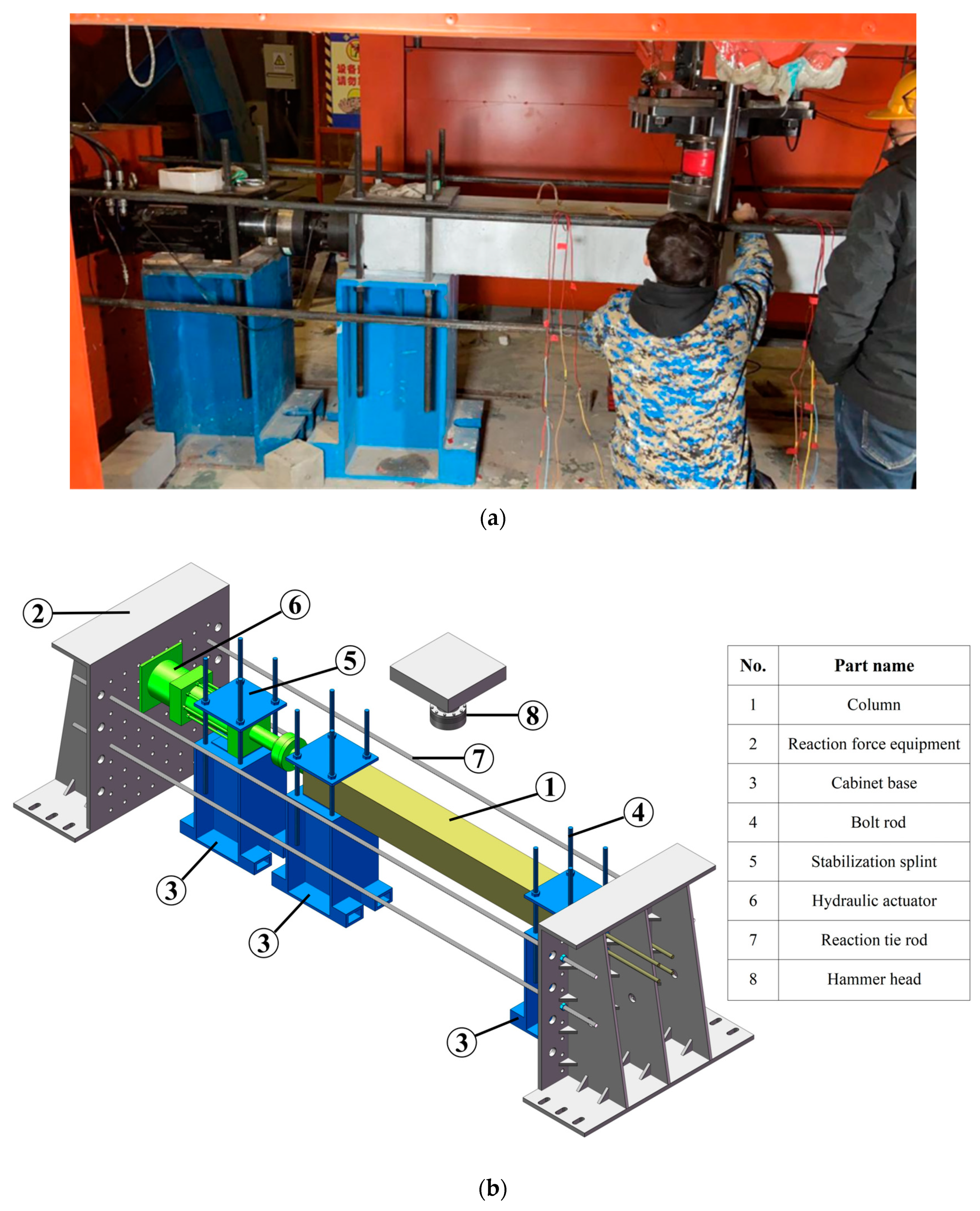
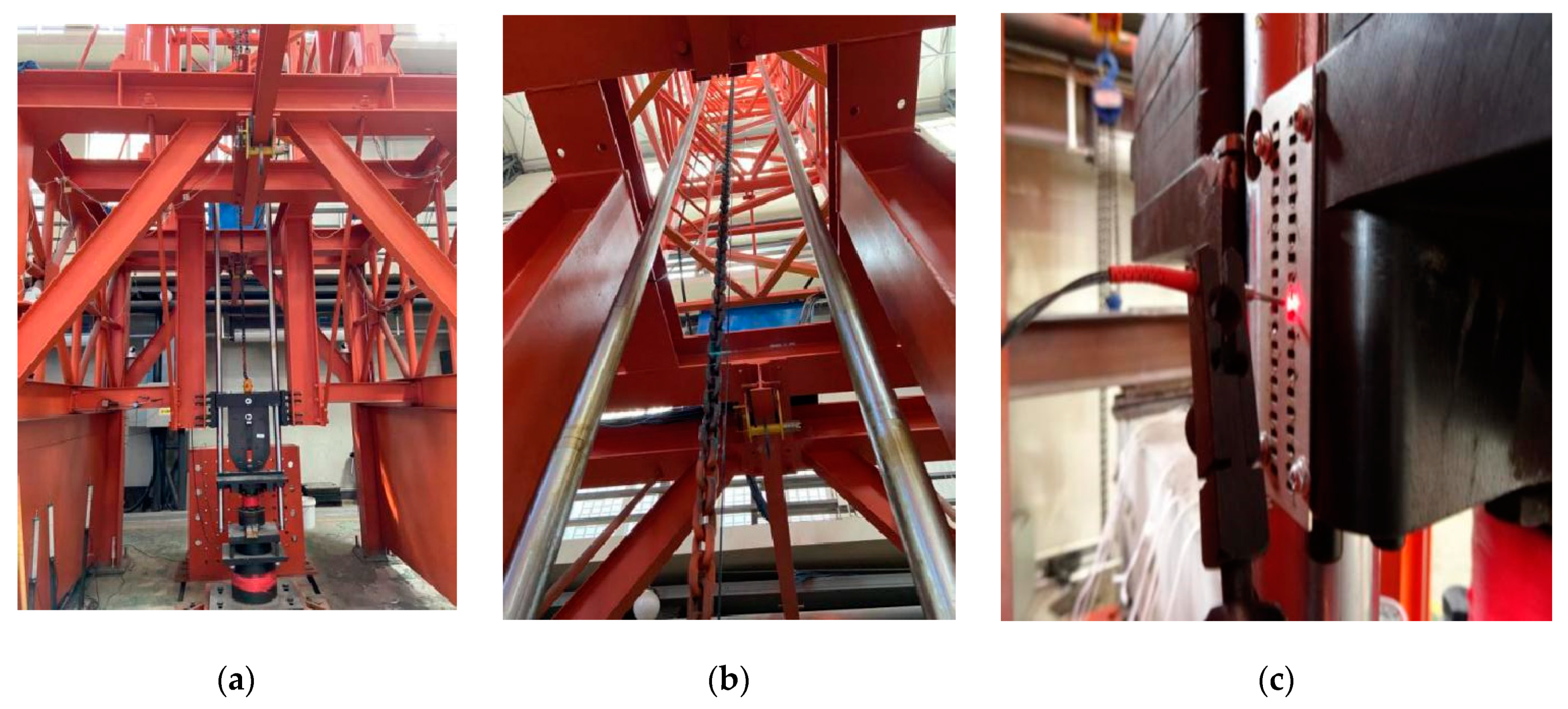
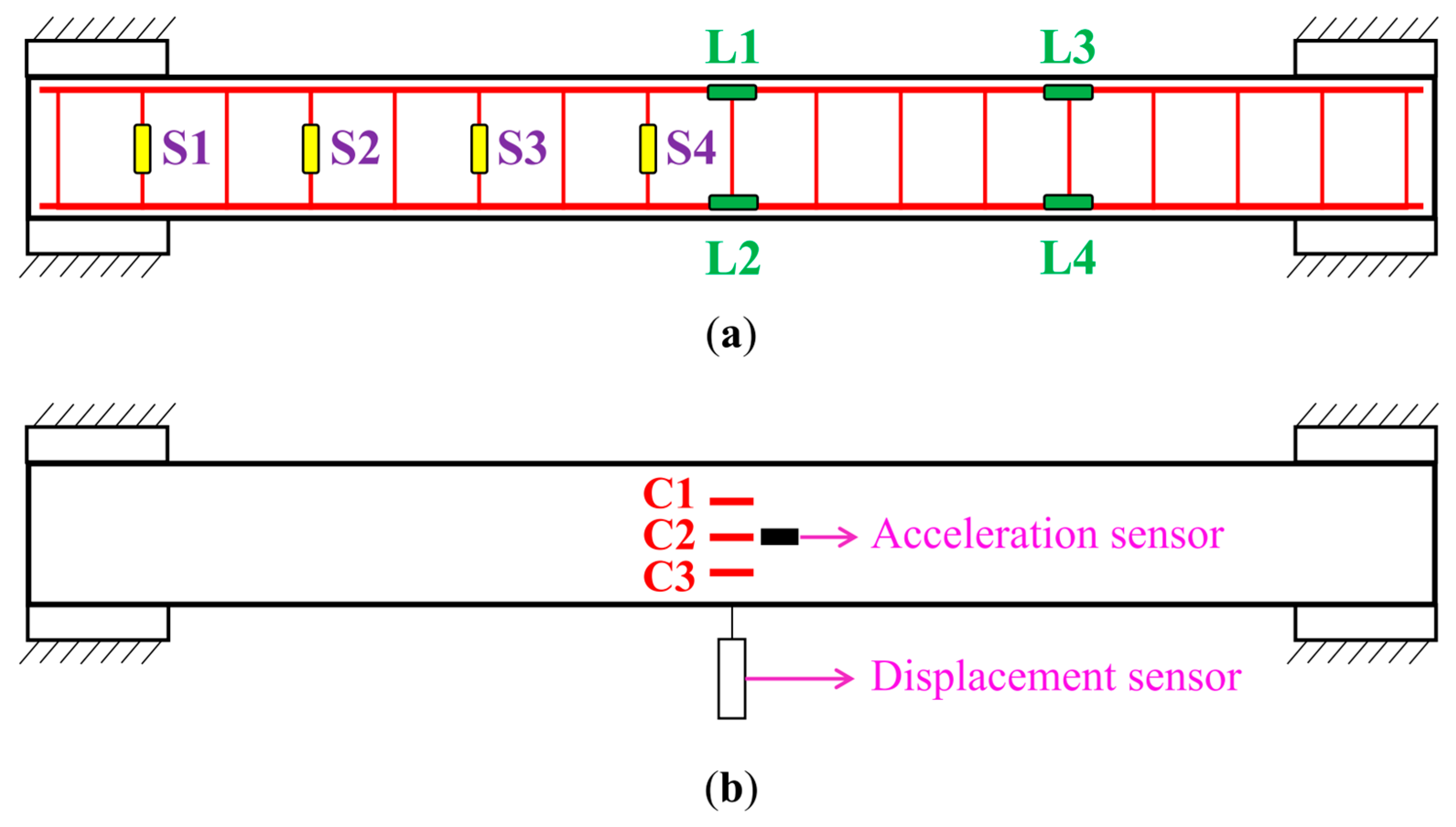
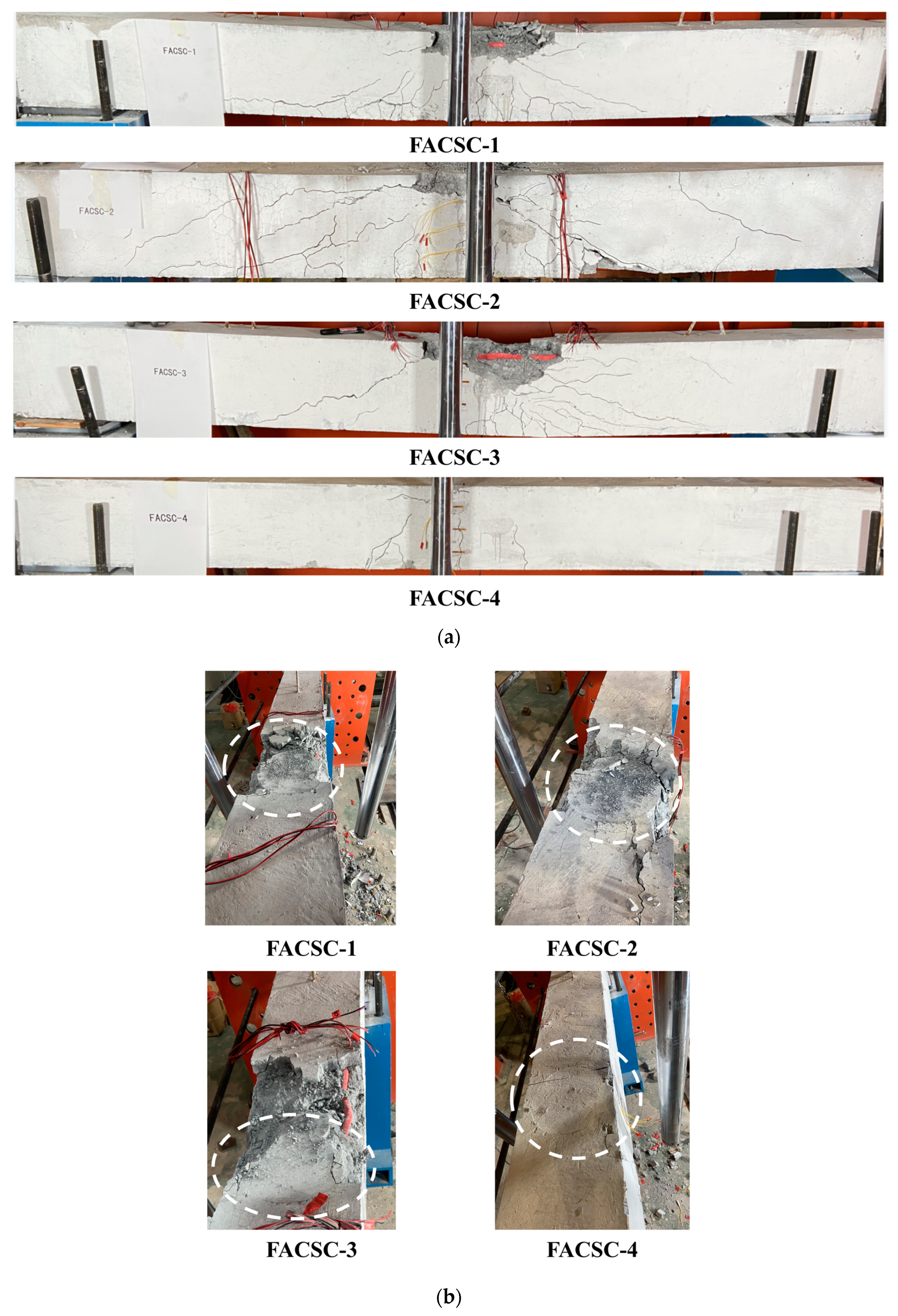


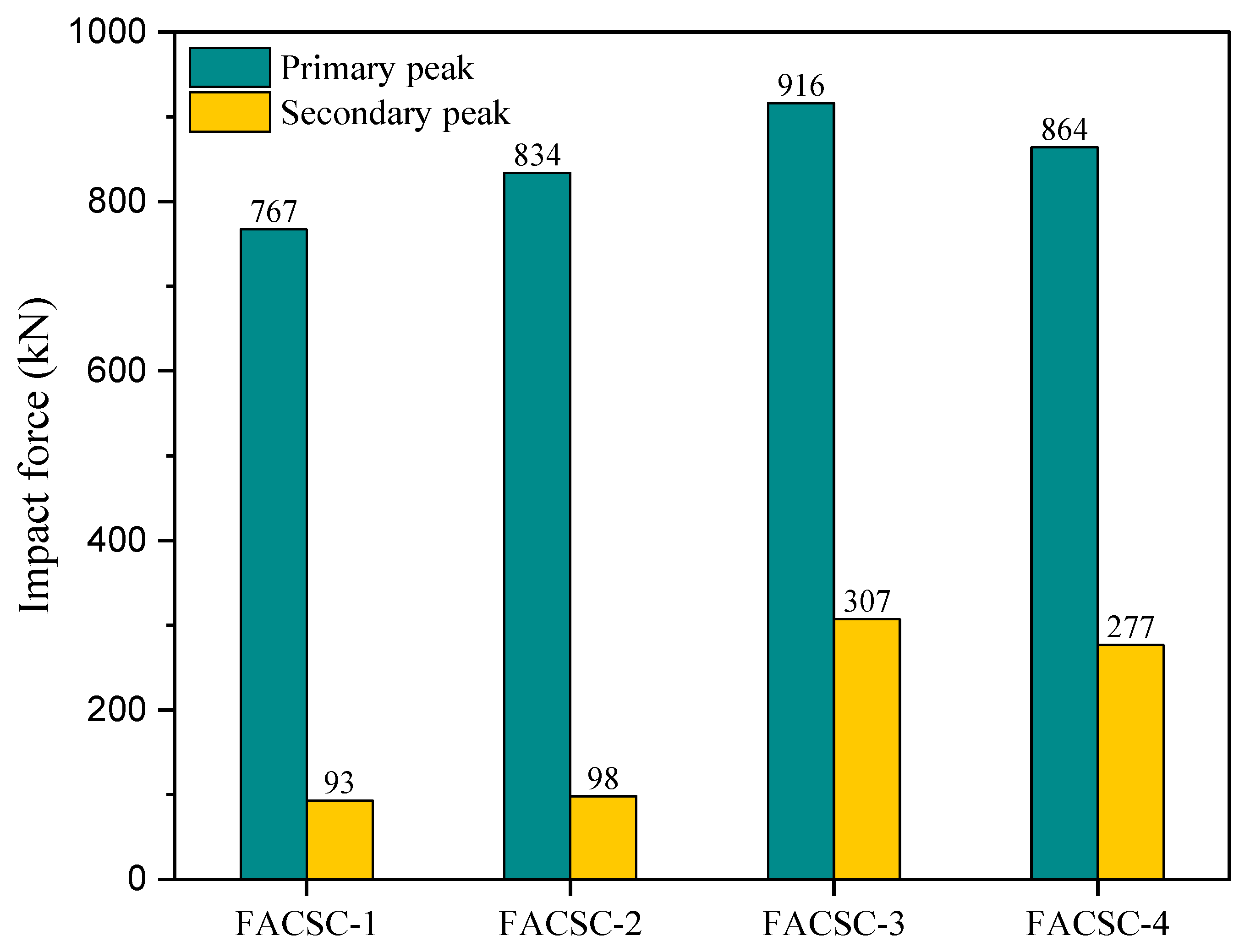

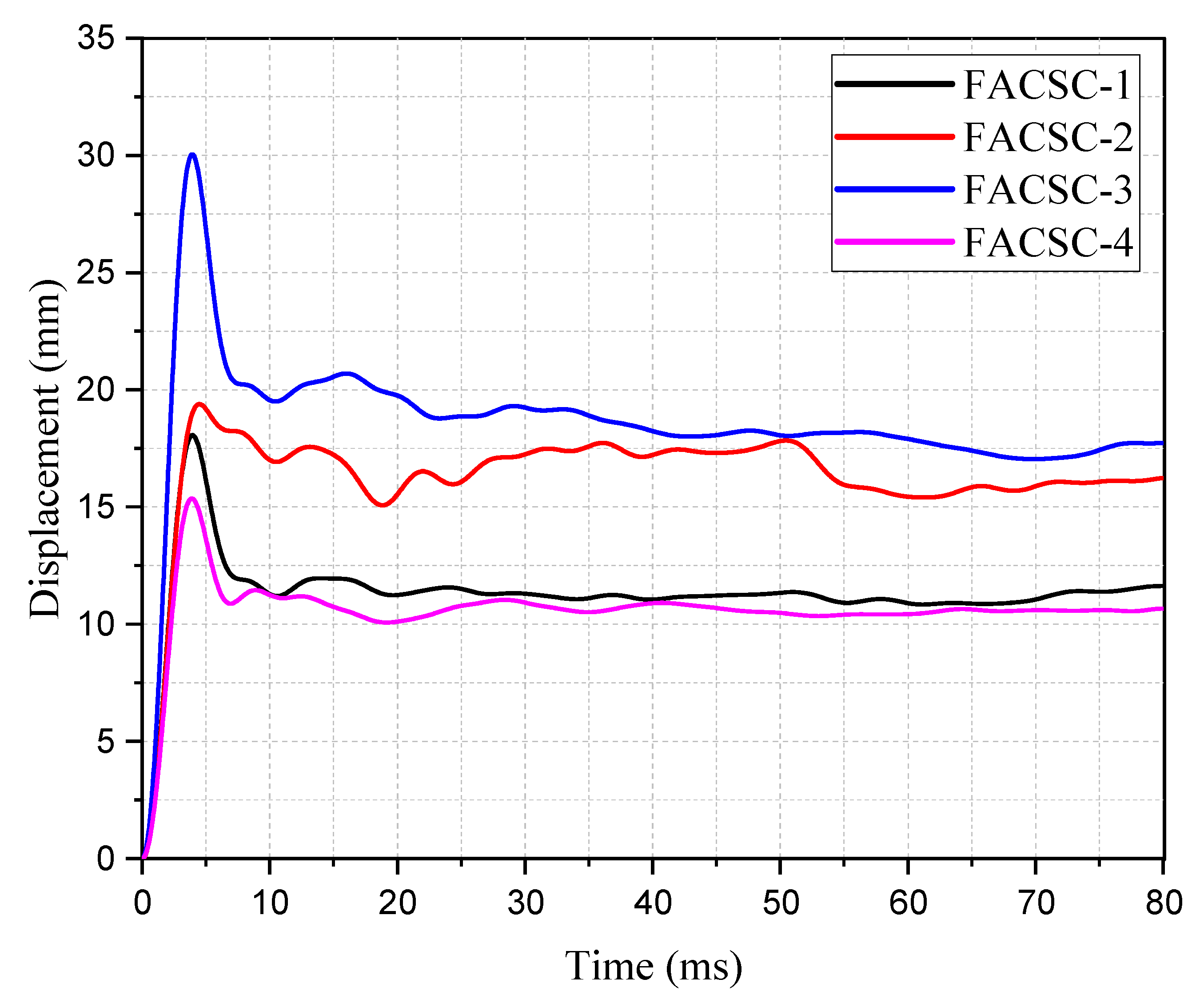
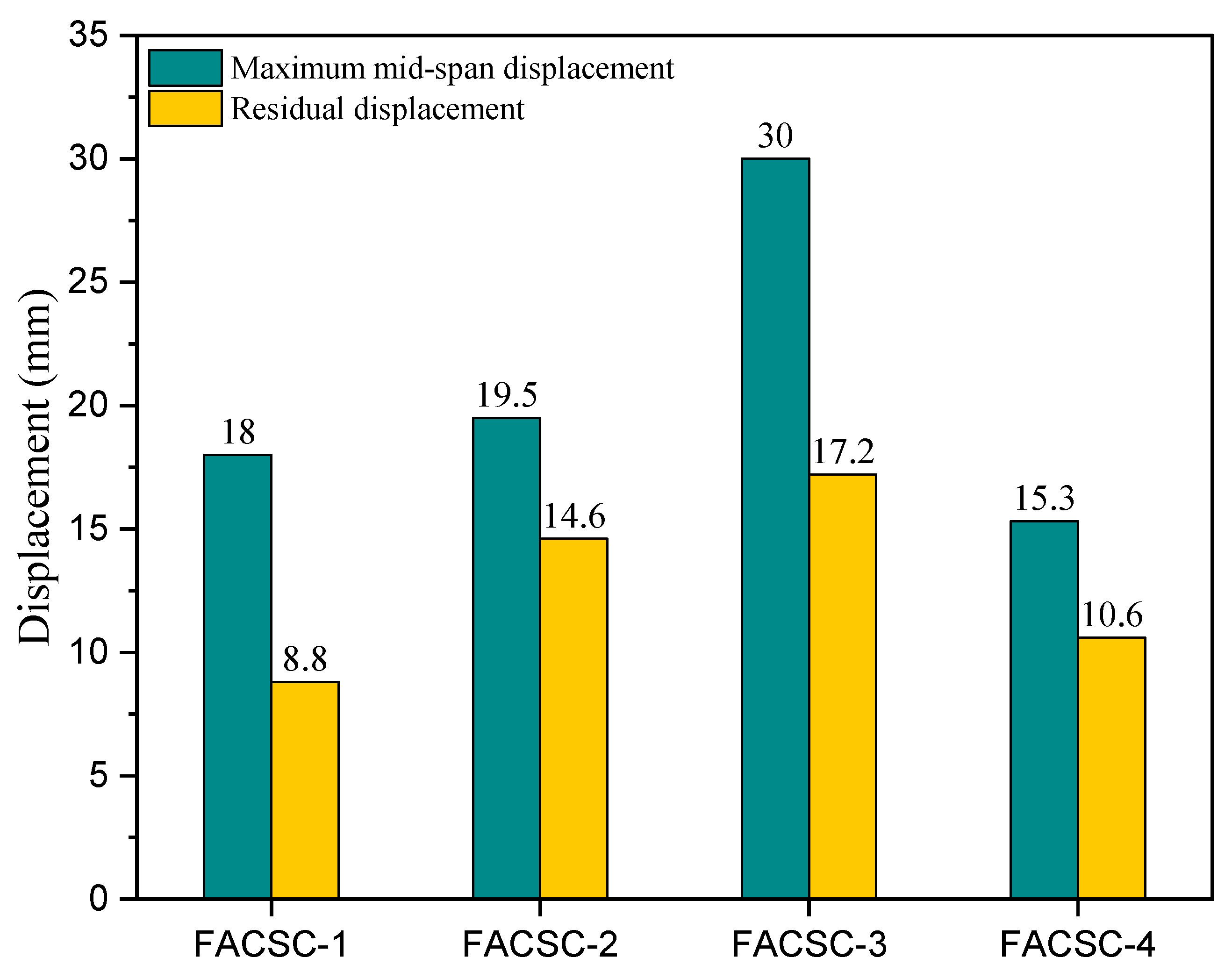
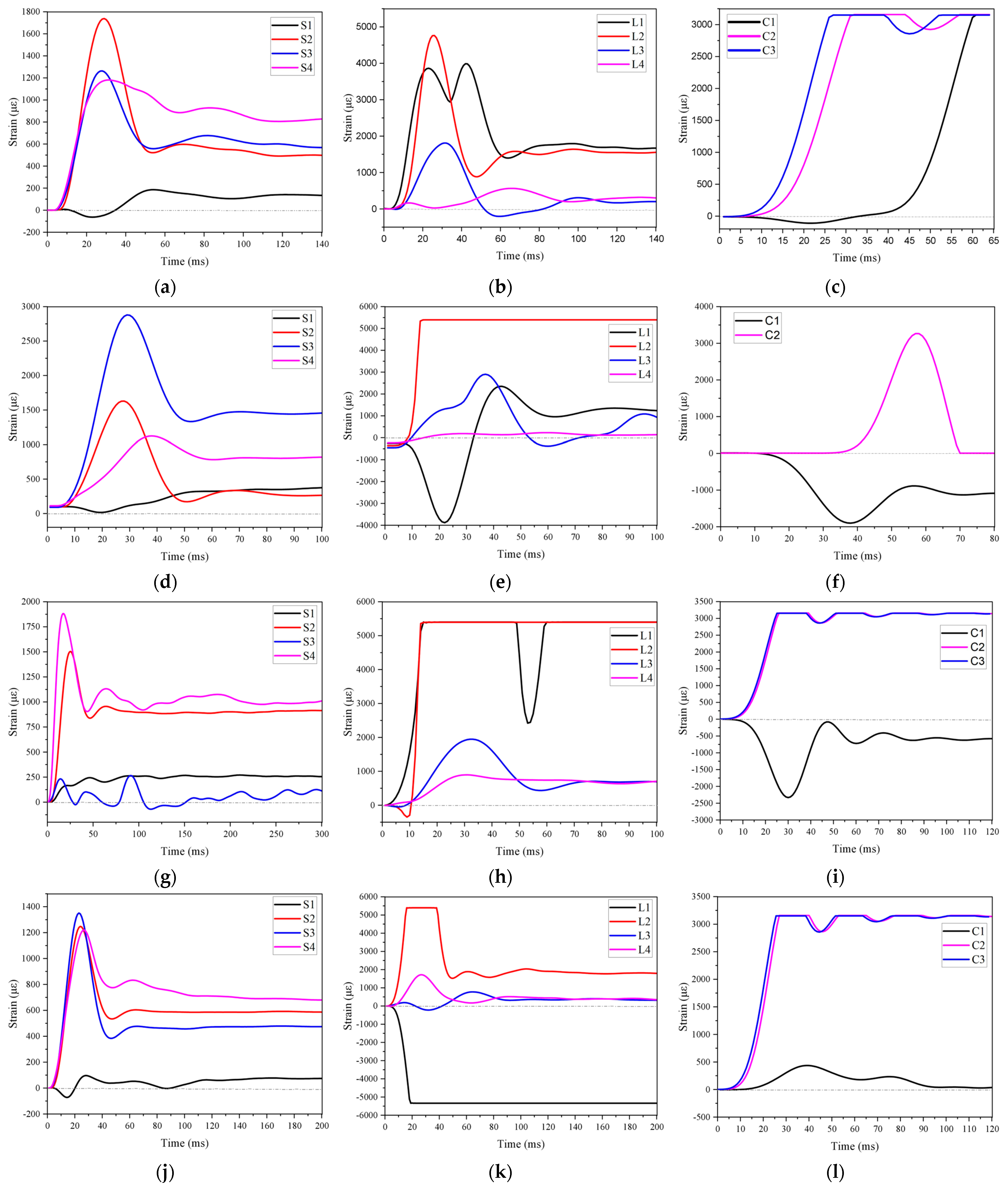

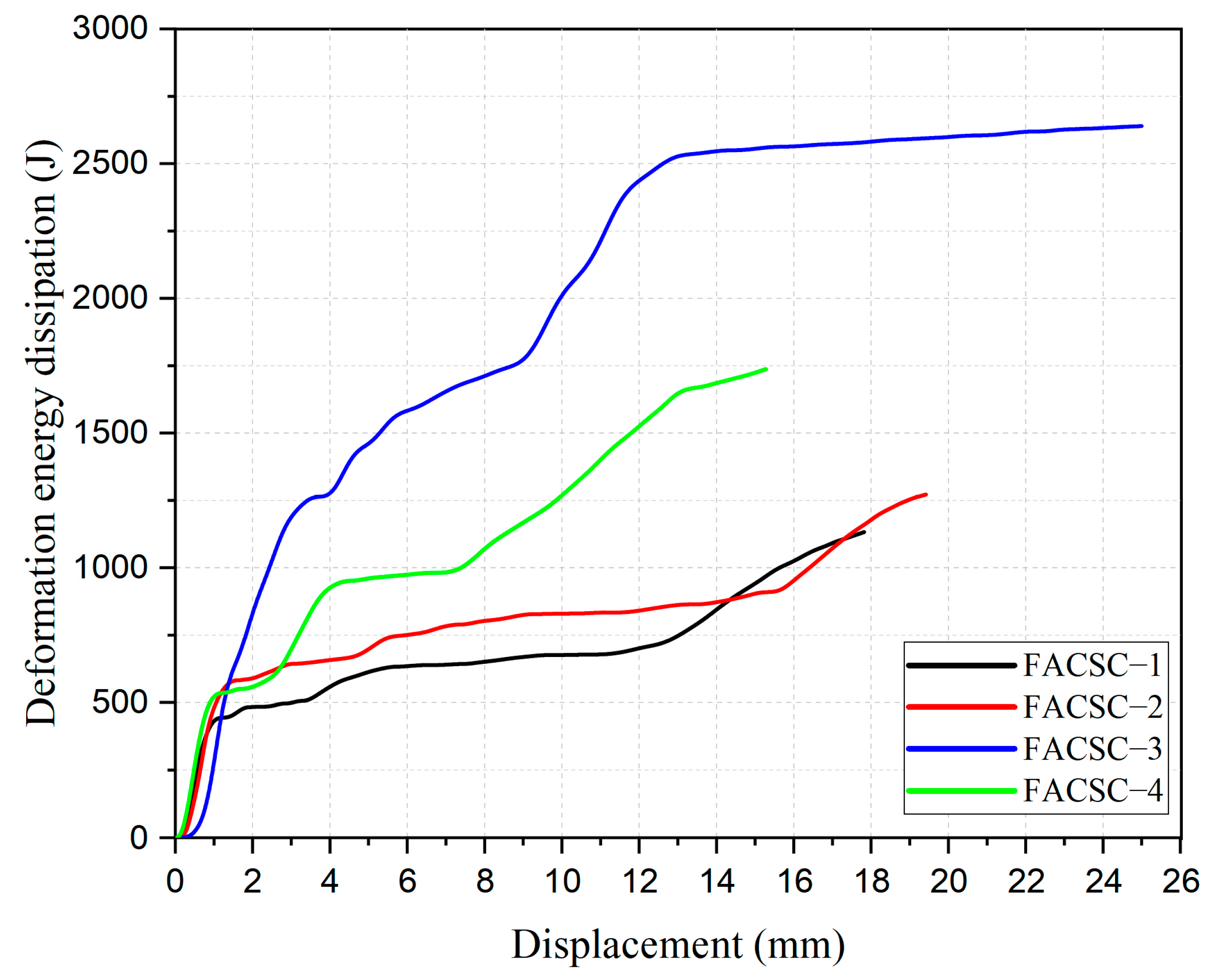

| No. | Steel Fiber Volume Ratio (%) | Axial Compression Ratio | b × h (mm) | Longitudinal Reinforcement | Stirrups | Reinforcement Ratio (%) | Stirrup Ratio (%) |
|---|---|---|---|---|---|---|---|
| FACSC-1 | - | 0.1 | 250 × 250 | 4C12 | A8@150 | 0.72 | 0.27 |
| FACSC-2 | - | 0.2 | |||||
| FACSC-3 | - | 0.3 | |||||
| FACSC-4 | 1 | 0.2 |
| Steel Fiber Volume Rate (%) | Cement (kg) | Fly Ash Ceramic Pellets (kg) | Pottery Sand (kg) | Fly Ash (kg) | Water Reducing Admixture (kg) | Water (kg) |
|---|---|---|---|---|---|---|
| - | 450 | 693 | 531 | 50 | 3.6 | 200 |
| 1 | 440 | 670 | 558 | 40 | 3.6 | 192 |
| Type of Steel Fiber | Thickness (mm) | Width (mm) | Length (mm) | Tensile Strength (MPa) |
|---|---|---|---|---|
| Shear Waveform | 1.0 | 2.0 | 50 | 780 |
| Bar Diameter (mm) | Yield Strength (MPa) | Ultimate Tensile Strength (MPa) | Elongation (%) | Elastic Modulus (GPa) |
|---|---|---|---|---|
| 12 | 471 | 628 | 15.02 | 195 |
| 8 | 438 | 610 | 17.04 | 198 |
| Steel Fiber Volume Rate (%) | Cubic Compressive Strength (MPa) | Axial Compressive Strength (MPa) | Split Tensile Strength (MPa) | Modulus of Elasticity (MPa) |
|---|---|---|---|---|
| - | 36.3 | 34.1 | 2.9 | 3.02 × 104 |
| 1 | 42.0 | 38.9 | 3.88 | 3.33 × 104 |
| No. | Steel Fiber Volume Rate (%) | Axial Load | m (kg) | h0 (m) | V0 (m/s) | E0 (J) | |
|---|---|---|---|---|---|---|---|
| Value (kN) | Ratio | ||||||
| FACSC-1 | - | 95 | 0.1 | 235 | 2.5 | 7 | 5758 |
| FACSC-2 | - | 190 | 0.2 | ||||
| FACSC-3 | - | 285 | 0.3 | ||||
| FACSC-4 | 1 | 217 | 0.2 | ||||
Disclaimer/Publisher’s Note: The statements, opinions and data contained in all publications are solely those of the individual author(s) and contributor(s) and not of MDPI and/or the editor(s). MDPI and/or the editor(s) disclaim responsibility for any injury to people or property resulting from any ideas, methods, instructions or products referred to in the content. |
© 2023 by the authors. Licensee MDPI, Basel, Switzerland. This article is an open access article distributed under the terms and conditions of the Creative Commons Attribution (CC BY) license (https://creativecommons.org/licenses/by/4.0/).
Share and Cite
Wang, X.; Wu, Q.; Gao, Z.; Sha, L. Study on Impact Resistance of All-Lightweight Concrete Columns Based on Steel Fiber Reinforced and Various Axial Compression Ratio. Buildings 2023, 13, 2076. https://doi.org/10.3390/buildings13082076
Wang X, Wu Q, Gao Z, Sha L. Study on Impact Resistance of All-Lightweight Concrete Columns Based on Steel Fiber Reinforced and Various Axial Compression Ratio. Buildings. 2023; 13(8):2076. https://doi.org/10.3390/buildings13082076
Chicago/Turabian StyleWang, Xiuli, Qinyuan Wu, Zhenguo Gao, and Lirong Sha. 2023. "Study on Impact Resistance of All-Lightweight Concrete Columns Based on Steel Fiber Reinforced and Various Axial Compression Ratio" Buildings 13, no. 8: 2076. https://doi.org/10.3390/buildings13082076
APA StyleWang, X., Wu, Q., Gao, Z., & Sha, L. (2023). Study on Impact Resistance of All-Lightweight Concrete Columns Based on Steel Fiber Reinforced and Various Axial Compression Ratio. Buildings, 13(8), 2076. https://doi.org/10.3390/buildings13082076






